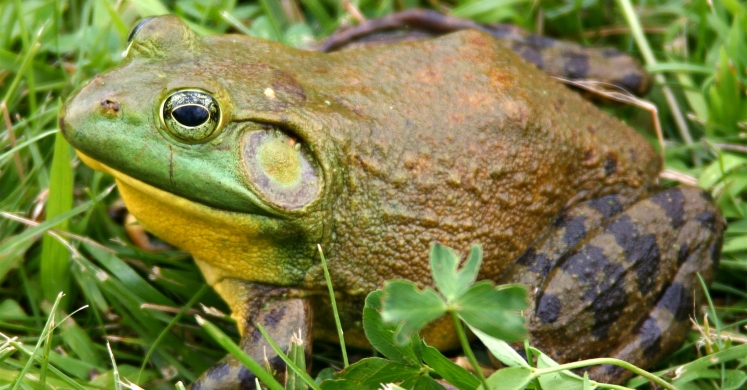Blog

#bioPGH Blog: A Frog Winter’s Nap
 A resource of Biophilia: Pittsburgh, #bioPGH is a weekly blog and social media series that aims to encourage both children and adults to reconnect with nature and enjoy what each of our distinctive seasons has to offer.
A resource of Biophilia: Pittsburgh, #bioPGH is a weekly blog and social media series that aims to encourage both children and adults to reconnect with nature and enjoy what each of our distinctive seasons has to offer.
If you stopped by Phipps’ lagoon over the summer, you probably lost count of the bullfrogs and tadpoles that hopped or swam in and out of view! With so many frogs milling about, have you ever wondered where they go in the wintertime? Do they burrow in the mud like turtles? Swim below the ice like fish? Hibernate like bears? Migrate like birds? Freeze? Let’s explore!
Frogs generally stay put and hibernate in the winter, but their strategy for winter survival depends on whether they are terrestrial or aquatic. Terrestrial frogs can either burrow down into the ground or leaf litter to hibernate or they may seek out shelter in tree holes, fallen logs, or miniature “caves” in rock. On the other hand, aquatic frogs hibernate in the water, and dissolved oxygen in the water is key to their survival. These frogs, like our bullfrogs in the lagoon, can undergo what is called “cutaneous gas exchange,” which means they can “breathe” through their skin. Amphibian skin has a higher density of tiny blood vessels than the average vertebrate, and those blood vessels are close to the surface of their skin. This allows oxygen to diffuse through the thin layer of skin to the blood vessels. During the active warm months, the oxygen frogs receive from cutaneous respiration wouldn’t suffice and they have to breathe with their lungs; but it is suitable in the winter when their metabolic rates drop sharply and the frogs move very little. Also, if you visited our lagoon in late summer, you probably saw quite a few bullfrog tadpoles swimming about. Since bullfrogs have a metamorphosis cycle that can last up to two years, their tadpoles must be able to survive the winter in the pond as well.
While overwintering, frogs live off stored energy reserves of lipids and glycogen they built up before hibernating. Lipids are essentially fats, which frogs accumulate during the warm months, and glycogen is a type of stored sugar that frogs accumulate in their livers and muscles. Since the frogs are barely, if at all, active (some aquatic frogs may move a bit while underwater), they burn through this energy slowly—which is important because they might hibernate from as early as October all the way until April.
However, terrestrial or aquatic, a frog’s greatest winter party trick is their freeze-tolerance. As temperatures drop, frog bodies produce glucose to protect their organs from the damaging part of freezing: crystallization. Ice crystals can cause cells to burst or damage their internal structures—neither of which is healthy for the animal. With frogs’ natural “anti-freeze,” they can be frozen to 0 F° (-18 C°) with no ill effects afterwards. Frogs can even undergo multiple freeze-thaw cycles, provided the freezing phase occurs slowly enough to give them time to produce glucose.
As a quick clarification, you may have heard the term “estivation” used to describe a similar biological process as hibernation. Though both processes are characterized by a drop in metabolism and inactivity on the frog’s part, estivation is a frog’s way of dealing with an intense dry season rather than winter’s cold. One noticeably different part of estivation from hibernation is that frogs will build up layers of shed skin around themselves as a way to prevent water loss (dessication). Both processes, though, are nature’s way of protecting frogs from extreme conditions that could otherwise be dangerous.
Connecting to the Outdoors Tip: We may not be able to hibernate through the colder months, but that means we get to bundle up and explore the wonderland that is Pennsylvania in the winter! If you do happen to stumble across what looks like a “frozen frog” while on a walk this winter, odds are the frog is fine—or will be, come spring.
Continue the Conversation: Share your nature discoveries with our community by posting to Twitter and Instagram with hashtag #bioPGH, and R.S.V.P. to attend our next Biophilia: Pittsburgh meeting.
Resources
National Aquarium—American Bullfrog
U.S. Forest Service—American Bullfrog
Scientific American—Where Do Frogs Go in the Winter? Why Don’t They Freeze to Death?
Jackson and Ultsch 2010: Physiology of Hibernation Under the Ice by Turtles and Frogs
Photo Credits: Pexels and Wikimedia user Carl D. Stowe CC-BY-SA-2.5

